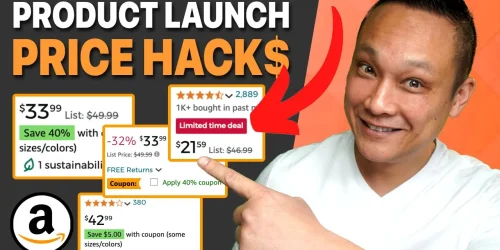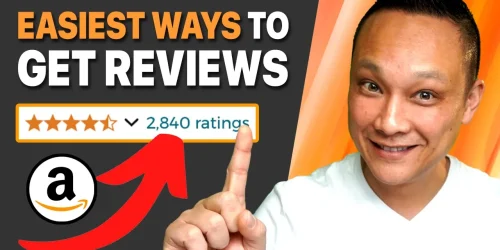Amazon Product Launch 4 Step Strategy that Gets Results
A common misconception for new Amazon sellers is thinking that listing your product and getting a few initial reviews is enough to start generating consistent sales.
While that might be a good start, it’s definitely not the full picture.
To truly succeed, your product listing needs to be fully optimized — meaning every single part of your listing works together to attract shoppers, rank higher in search results, and convert visitors into paying customers.
In this post, I’ll take you step-by-step through how to optimize your Amazon product listing and rank #1, using proven strategies that I personally use and teach.
There are three major steps to creating a fully optimized listing:
- Keyword Research
- Keyword Integration
- Photo and Review Optimization
Let’s go through each one in detail.
🧠 Step 1: Keyword Research — The Foundation of Amazon SEO
Keyword research is the number one most important step in listing optimization.
Why?
Because the keywords you use in your title, bullet points, and backend fields directly determine whether your product will show up when shoppers search on Amazon.
🔍 Understanding How the Amazon A9 Algorithm Works
Amazon’s A9 algorithm has one main goal: to make Amazon money.
Every time a shopper searches for a product, Amazon wants to show the listings that are most likely to generate sales.
So your goal is to create a listing that performs well across two main factors:
| Ranking Factor | Description |
|---|---|
| Keyword Relevancy | Does your listing clearly match what the shopper is looking for? |
| Sales Performance | Does your product consistently make sales and convert well? |
If your listing scores high on both — relevancy and performance — Amazon will reward you with higher visibility.
Now, since you can’t directly control sales (that’s the result of good optimization), what you can control are the keywords you target.
🎯 Why You Must Use Amazon-Specific Keyword Tools
People searching on Google and Amazon have completely different intentions:
- Google searches are informational (“how to fix a tent pole”)
- Amazon searches are transactional (“best tent stakes for camping”)
That’s why tools like Google AdWords or other SEO software won’t help you here — they’re not built for Amazon’s search intent.
Instead, you need Amazon-specific keyword tools like:
| Tool | Purpose | Highlights |
|---|---|---|
| Helium 10 | Keyword research, listing optimization, and product tracking | Includes Cerebro and Magnet for powerful keyword discovery |
| SelleRise | Keyword research based on sales data | Keyword Hunter tool finds high-performing keywords based on real Amazon sales |
👉 Pro Tip: Use both tools together — Helium 10 for search volume, and SelleRise for sales-driven data.
Once you’ve built your keyword list, you’re ready for Step 2.
🧩 Step 2: Keyword Integration — Optimizing Your Listing Copy
Now that you have your keyword list, it’s time to strategically place them throughout your listing.
But here’s where most sellers go wrong — they stuff their listings with keywords, making them unreadable for humans. Remember: Amazon indexes your listing for keywords, but humans decide whether to buy.
Let’s break down how to properly use your keywords in each section.
🏷️ Product Title Optimization
Your product title is one of the most powerful parts of your listing.
It’s what shoppers see first in search results, along with your main image and review rating.
Amazon allows up to 200 characters for your title — use them wisely.
✅ A Great Product Title Should:
- Include your primary keyword at the beginning
- Clearly describe what the product is and what it does
- Mention key features or benefits
- Be easy to read and understand
🚫 Avoid:
- Keyword stuffing (repeating the same phrases)
- Including your brand name (Amazon automatically adds it)
- Using commas — instead, use the pipe symbol (|) to separate phrases for readability.
Example of a Good Title:
Camping Tent Stakes | Heavy-Duty Aluminum Tent Pegs for Hard Ground | Includes Carry Bag | Rust-Resistant and Lightweight
💬 Bullet Points — Benefits Over Features
Your bullet points should tell a story that connects emotionally with shoppers. Focus on benefits, not just features.
Bad Example:
“Made from high-grade aluminum. Includes 8 stakes. Lightweight design.”
Good Example:
“Never struggle with flimsy stakes again — our heavy-duty aluminum tent pegs stay secure even in high winds, keeping your tent anchored no matter the weather.”
✅ Bullet Point Best Practices:
- Limit each bullet to 1–2 concise sentences
- Highlight problems and show how your product solves them
- Include your main keywords naturally
- Make them skimmable and visually easy to read
📝 Product Description — Expand the Story
Your product description is where you can go deeper.
Use this section to explain:
- Additional benefits
- Product details that didn’t fit in the bullet points
- Brand story or unique differentiators
Keep it conversational, and sprinkle in secondary keywords naturally.
⚙️ Backend Keywords — Don’t Waste This Space
The backend keyword fields (in your Seller Central listing editor) are where you can include extra keywords you couldn’t fit in your public listing.
Tips:
- Separate each keyword with a space (no commas)
- Don’t repeat words already in your title or bullets
- Keep under 250 bytes total (Amazon’s character limit)
- Avoid brand names or irrelevant keywords
⚡ Step 3: Photo Optimization — The Visual Selling Machine
Your product photos are arguably the most powerful sales driver in your listing.
Studies show that 90% of buying decisions on Amazon are influenced by photos.
Think about it — before reading anything, shoppers glance at:
- Main photo
- Price
- Reviews
- Title
If your main photo doesn’t grab attention instantly, shoppers will scroll right past you.
📸 Professional Product Photography Is Non-Negotiable
Don’t try to take your own photos.
Hire a professional product photographer (you can easily find one on Fiverr).
Expect to pay between $300–$800, and it’s worth every dollar.
Why?
Because quality photos communicate trust, professionalism, and perceived value.
Pro Tip: If your product doesn’t photograph well (e.g., dark or reflective materials), consider having a 3D model created.
3D renders can be lit, colored, and positioned perfectly — and often look indistinguishable from real photography.
📷 Photo Strategy — Focus on Benefits, Not Just Angles
Don’t just show your product from multiple angles.
Every image should tell a story and connect to a pain point or benefit.
| Photo Type | Purpose | Example |
|---|---|---|
| Main Image | Grab attention in search results | Clean white background, fills the frame |
| Benefit Image | Show how it solves a problem | “Won’t bend or pull out of the ground” |
| Lifestyle Image | Help customers visualize using it | “Used during camping trips or windy days” |
| Feature Image | Highlight materials or quality | “Rust-proof aluminum |
| Comparison Image | Differentiate from competitors | “50% stronger than steel stakes” |
🧱 A+ Content (for Brand Registered Sellers)
If you’re brand registered, you can use A+ Content to add enhanced visuals and layouts to your listing.
However — don’t make it only photos.
Search engines like Amazon and Google can’t read text inside images, so include plenty of descriptive text too.
Use the A+ section to reinforce:
- Product benefits
- Problem/solution messaging
- Brand story and credibility
⭐ Step 4: Reviews — The Trust Factor
Even the best-optimized listing won’t convert without reviews.
Shoppers want proof that your product delivers what it promises.
- Products with 4+ stars and consistent reviews convert exponentially better.
- Avoid fake reviews — Amazon’s detection is advanced and unforgiving.
If you’re launching a new product and need your first reviews quickly, check out my guide:
👉 How to Get 100s of Reviews Fast for a Viral Amazon Product Launch
💡 Bonus Tip: Use Helium 10 to Simplify Everything
Once you’ve done your keyword research and copywriting, you can use Helium 10’s Listing Builder to streamline the process.
This tool highlights keywords in real time as you write your listing — so you’ll know exactly which keywords you’ve already used and which ones you’re missing.
👉 Click here to start using Helium 10 free today
🚀 Final Thoughts
Ranking #1 on Amazon isn’t about luck — it’s about strategy.
When you combine:
- Smart keyword research
- Strategic keyword integration
- Professional, benefit-driven photos
- Consistent reviews and A+ content
You create a listing that converts clicks into customers and builds momentum that Amazon’s algorithm loves.
Take the time to do it right the first time, and you’ll watch your sales — and rankings — climb higher every week.
Ready to get started?
👉 Start your free Helium 10 trial and begin optimizing your product listings like a pro today.





